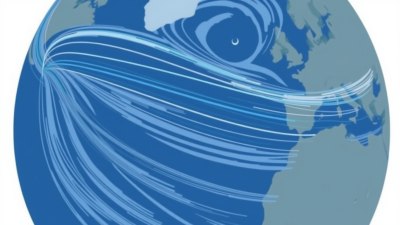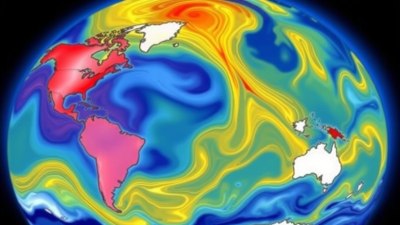How the Jet Stream Drives Global Weather
Explore how the jet stream influences global weather patterns, affecting climate, storms, and temperature variations worldwide.

Image created with Flux Schnell
The jet stream is a powerful, fast-flowing air current in the upper atmosphere that significantly shapes global weather patterns. Found at altitudes of around 10 to 15 kilometers, these narrow bands of strong wind can reach speeds of over 400 kilometers per hour. The dynamic behavior of jet streams influences the movement of weather systems, temperature distributions, and even the intensity of storms in various regions around the world. Understanding how the jet stream operates provides important insights into weather forecasting and climate science.
Jet streams form primarily due to the uneven heating of Earth's surface by the sun. The equator receives more solar energy compared to the poles, creating temperature gradients in the atmosphere. The Coriolis effect, resulting from Earth's rotation, causes the movement of air along these temperature boundaries to curve, creating the characteristic wavy patterns of jet streams. These high-altitude winds thus act as boundaries between colder polar air to the north and warmer tropical air to the south in the Northern Hemisphere, with a similar setup in the Southern Hemisphere.
Major Jet Streams and Their Locations
Two primary jet streams dominate the upper atmosphere: the polar jet stream and the subtropical jet stream. The polar jet stream flows between latitudes 50 and 60 degrees north and south, forming mainly due to the sharp temperature contrast between cold polar air and warmer mid-latitude air. This jet is typically stronger in winter when temperature differences are greatest.
The subtropical jet stream exists closer to 30 degrees latitude in both hemispheres. It arises from temperature contrasts between the tropical and subtropical atmosphere and usually remains stronger during the summer months. Both jet streams meander in wave-like patterns influenced by underlying topography, ocean temperatures, and seasonal variations.
Jet Stream’s Role in Weather Patterns
The jet stream acts as a guiding force for weather systems such as cyclones, anticyclones, and frontal boundaries. The position and shape of the jet stream determine the path storms follow. For example, when the polar jet stream dips southward, it can bring cold, arctic air to lower latitudes, causing sudden drops in temperature and snowstorms in typically warmer areas.
Conversely, a northward bulge or ridge in the jet stream allows warm air masses to move poleward, often leading to heatwaves or dry conditions in affected regions. These meanders—known as Rossby waves—create alternating troughs and ridges of low and high pressure, influencing precipitation patterns and temperature anomalies worldwide.
Jet Stream and Extreme Weather Events
The behavior of the jet stream is closely linked to extreme weather occurrences. Persistent blocking patterns, where the jet stream's waves become stationary or slow-moving, can lead to prolonged weather conditions. For instance, a stationary ridge in the jet stream can trap a heat dome over an area, causing extended heatwaves and drought. Similarly, a blocking trough can cause cold spells and significant snowfall if it stalls over a region.
During hurricane seasons, the jet stream’s position can inhibit or enhance the development and trajectory of tropical storms. Typically, the subtropical jet stream can shears tropical storms, weakening them or steering them away from land. Conversely, shifts in jet stream patterns may allow storms to intensify and impact coastal areas, increasing the potential for destructive weather.
Jet Stream Variability and Climate Change
In recent decades, scientists have observed changes in the jet stream's patterns, potentially linked to global climate change. Warming in the Arctic is reducing the temperature gradient between the poles and the tropics, which can weaken the jet stream's winds. A weaker jet stream tends to become more wavy and unstable, resulting in more extreme and longer-lasting weather events such as heavy rainfall, floods, and extreme cold spells.
Research also indicates that melting Arctic sea ice affects the jet stream’s jet flow. Reduced ice cover alters atmospheric pressure systems and surface temperatures, further influencing the jet stream’s meanders and speed. These changes carry profound implications for regional climates, agriculture, water resources, and disaster preparation.
Jet Stream and Seasonal Weather Forecasting
Meteorologists closely monitor jet stream patterns to improve weather forecasting accuracy, especially over longer time frames. Seasonal forecasts often rely on understanding how the jet stream is expected to behave in the coming months, influenced by phenomena such as El Niño or La Niña. These tropical Pacific Ocean conditions can modify the jet stream’s path, leading to shifts in precipitation and temperature patterns worldwide.
By predicting the position of the jet stream, forecasters can anticipate periods of drought, flooding, or unseasonal temperature trends. For instance, during an El Niño event, the jet stream tends to travel farther south, often bringing wetter conditions to southern United States and drier weather to parts of Southeast Asia. These insights assist governments and industries in preparing for climate impacts on agriculture, energy demand, and emergency response.
Jet Stream and Aviation
The jet stream also plays a crucial role in aviation. Commercial aircraft often utilize jet streams to reduce flight times and fuel consumption when traveling in the same direction as the air current. Conversely, flying against a strong jet stream can increase flight duration and fuel use. Pilots rely on real-time data on jet stream location and strength to plan optimal routes for efficiency and safety.
However, the jet stream's turbulences and sharp wind gradients also contribute to atmospheric instability known as clear-air turbulence. This turbulence can affect passenger comfort and aircraft safety, making understanding jet stream dynamics vital for aviation meteorology and flight planning.
Influence of Jet Stream on Regional Climates
The jet stream’s influence varies by region, shaping local climate conditions over both short and long terms. In North America, the polar jet stream steers storms across the continent, impacting winter snowstorms and summer thunderstorms. Shifts in the jet stream’s typical pathways can cause significant drought or flood events.
In Europe, the jet stream governs the frequency and intensity of Atlantic storm tracks, thus affecting rainfall and temperature patterns. For example, a northward displaced jet stream can lead to drier conditions in southern Europe and wetter weather in northern parts. Similarly, in Asia, the jet stream interacts with the monsoon systems, modulating seasonal rainfall crucial for agriculture and water supply.
How Jet Streams Are Studied
Studying the jet stream involves combining data from satellites, weather balloons, aircraft observations, and ground-based radar systems. Satellites track temperature, wind speed, and cloud patterns at high altitudes, providing comprehensive views of jet stream behavior. Weather balloons launched globally measure wind direction and speed at various altitudes, helping meteorologists map the jet streams in real time.
Advanced computer models simulate atmospheric conditions to project jet stream movements days or weeks ahead, aiding long-term weather prediction. These models incorporate complex physics of the atmosphere, ocean interactions, and solar radiation effects to capture jet stream dynamics accurately.
Human Impact and Future Jet Stream Research
Human activities affecting greenhouse gas emissions indirectly influence jet stream behavior by altering Earth’s temperature gradients. Continued global warming and polar amplification are likely to make jet streams more erratic, intensifying weather extremes. Understanding these changes is critical for adapting societies to evolving climate risks.
Future research aims to improve the precision of jet stream models and enhance forecasting capabilities. Scientists are exploring artificial intelligence and machine learning techniques to analyze vast atmospheric datasets, seeking to uncover patterns that predict rapid jet stream shifts or blocking events. Better knowledge will support disaster preparedness and climate resilience globally.
In summary, the jet stream is a central component of Earth's atmospheric system that drives global weather by interacting with temperature gradients, steering storms, and influencing climate variability. Its complex and dynamic nature makes it a focal point of meteorology and climate science, essential for interpreting past, present, and future weather trends.











